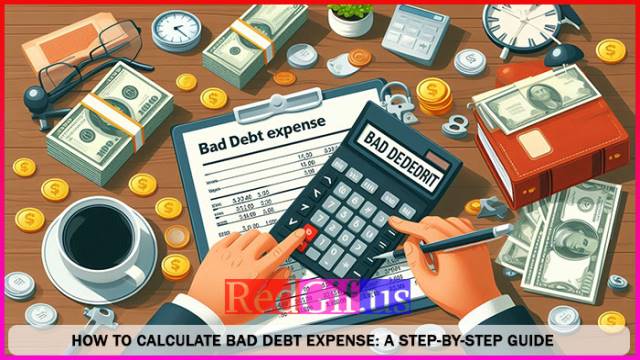How to Calculate Bad Debt Expense: A Step-by-Step Guide

Managing a business’s finances is a juggling act and one of the key parts is dealing with bad debt. Knowing how to calculate bad debt correctly can make a big difference to your financials and overall business health.
The Problem: Bad Debts
Every business extends credit to its customers and hopes payments will come in on time. But not all customers pay on time and bad debts happen. Unpaid invoices can disrupt cash flow, distort financials and obscure the true health of your business.
Imagine running a small business where you’ve extended credit to several customers. Suddenly a few of them default on their payments. Without a way to account for these bad debts your financials will show inflated revenues and assets and give a misleading picture of profitability and financial health.
Agitating the Issue: The Consequences of Bad Debts
Unmanaged bad debts can cause:
- Cash Flow Problems: Unpaid debts mean less cash on hand to cover expenses, pay employees or invest in growth opportunities.
- Inaccurate Financial Statements: Not accounting for bad debts your income statement will show higher revenues than actual and affect profitability ratios and mislead stakeholders.
- Tax Implications: Overstated income means you’ll pay more tax than necessary and impact your bottom line.
- Creditworthiness: Persistent bad debts will damage your business’s credit rating and make it harder to get loans or good terms with suppliers.
These problems show why you need to calculate and account for bad debt correctly to maintain financial integrity and operational efficiency.
The Solution: Calculating Bad Debt Expense
Calculating bad debt expense involves estimating the amount of receivables that won’t be collected. There are two ways to calculate bad debt expense:
- Percentage of Sales Method
- Aging of Accounts Receivable Method
1. Percentage of Sales Method
This method estimates bad debt expense as a fixed percentage of total sales. Easy and good for businesses with steady sales and collection habits.
- Total Credit Sales: Total sales made on credit for the period.
- Bad Debt Percentage: Based on historical data, industry standards or company policy, what percentage of sales will become bad debts.
2. Bad Debt Expense: Total Credit Sales x Bad Debt Percentage
Formula: Bad Debt Expense=Total Credit Sales×Estimated Bad Debt Percentage\text{Bad Debt Expense} = \text{Total Credit Sales} \times \text{Estimated Bad Debt Percentage}Bad Debt Expense=Total Credit Sales×Estimated Bad Debt Percentage
Example: If your business made $500,000 in credit sales and estimates that 2% may not be collected: Bad Debt Expense=$500,000×0.02=$10,000\text{Bad Debt Expense} = \$500,000 \times 0.02 = \$10,000Bad Debt Expense=$500,000×0.02=$10,000
2. Aging of Accounts Receivable Method
This method involves analyzing accounts receivable based on the length of time they’ve been outstanding. It provides a more precise estimate by recognizing that older receivables are less likely to be collected.
Steps:
- Categorize Receivables by Age: Group accounts receivable into categories (e.g., 0-30 days, 31-60 days, 61-90 days, over 90 days).
- Apply Percentage Estimates: Assign a higher probability of default to older receivables. For example:
- 0-30 days: 1%
- 31-60 days: 5%
- 61-90 days: 10%
- Over 90 days: 20%
- Calculate Estimated Uncollectible Amounts: Multiply each category’s receivables by the corresponding percentage.
- Sum the Estimates: Add up all the estimated uncollectible amounts to determine the bad debt expense.
Example:
| Age of Receivables | Amount ($) | Estimated % Uncollectible | Estimated Uncollectible ($) |
| 0-30 days | 100,000 | 1% | 1,000 |
| 31-60 days | 50,000 | 5% | 2,500 |
| 61-90 days | 30,000 | 10% | 3,000 |
| Over 90 days | 20,000 | 20% | 4,000 |
| Total | 200,000 | 10,500 |
In this example, the bad debt expense would be $10,500.
Which Method to Use
The choice between Percentage of Sales and Aging of Accounts Receivable depends on your business and the predictability of your receivables. Aging is more accurate as it takes into account the specific circumstances of each receivable, Percentage of Sales is simpler and for businesses with stable and predictable sales.
Example: Bad Debt Expense in Action
Let’s see how this works in practice.
Business
ABC Manufacturing is a medium size business that makes industrial components. They offer 30 day terms to their customers. Over the past year their accounts receivable has been all over the place so they need to estimate bad debt expense accurately.
Applying the Aging of Accounts Receivable Method
Step 1: Categorize Receivables
ABC Manufacturing reviews their accounts receivable as of December 31, 2023:
| Age of Receivables | Amount ($) |
| 0-30 days | 150,000 |
| 31-60 days | 80,000 |
| 61-90 days | 40,000 |
| Over 90 days | 30,000 |
| Total | 300,000 |
Step 2: Assign Uncollectible Percentages
Based on historical data, ABC Manufacturing assigns the following percentages:
| Age of Receivables | Estimated % Uncollectible |
| 0-30 days | 1% |
| 31-60 days | 3% |
| 61-90 days | 7% |
| Over 90 days | 15% |
Step 3: Calculate Estimated Uncollectible Amounts
| Age of Receivables | Amount ($) | Estimated % | Uncollectible ($) |
| 0-30 days | 150,000 | 1% | 1,500 |
| 31-60 days | 80,000 | 3% | 2,400 |
| 61-90 days | 40,000 | 7% | 2,800 |
| Over 90 days | 30,000 | 15% | 4,500 |
| Total | 300,000 | 11,200 |
Step 4: Record the Bad Debt Expense
ABC Manufacturing records a bad debt expense of $11,200 for 2023. This will ensure their financial statements reflect the potential losses from uncollectible accounts and give a true picture of their financial position.
Best Practices for Managing Bad Debt Expense
Calculating bad debt expense is only one part of good financial management. Here are some best practices to minimize bad debts and your expense estimates:
- Credit Policies: Have clear credit policies and do credit checks on new customers before extending credit.
- Monitor Receivables: Review your accounts receivable ageing reports regularly to catch potential issues early and act proactively.
- Collections Process: Have a collections process in place to follow up on overdue accounts promptly. This can include reminders, calls or involving collection agencies if needed.
- Diversify Customer Base: Don’t rely too much on a few customers. A diversified customer base reduces the risk of a single bad debt.
- Insurance and Guarantees: Consider credit insurance or get personal or corporate guarantees for large accounts to mitigate potential losses.
Conclusion
Calculating bad debt expense is important for your financial statements and business stability. By understanding and applying methods like Percentage of Sales and Aging of Accounts Receivable you can estimate and manage bad debts. By incorporating these into your financial management you will protect your business from the effects of outstanding debts and long term success.
FAQs
What is bad debt expense?
Bad debt expense is an accounting term that means the estimated amount of accounts receivable that a business will not collect. It’s the cost of giving credit to customers who may not pay.
How does bad debt expense affect financial statements?
Bad debt expense reduces net income on the income statement and accounts receivable on the balance sheet. This adjustment gives a true picture of a company’s financial position by accounting for potential losses from uncollectible debts.
Can bad debt be recovered?
Yes, sometimes bad debts can be recovered partially or fully through collections, legal action or negotiations with the debtor. When recovered it is recorded as a credit to bad debt expense and a debit to cash or accounts receivable.


